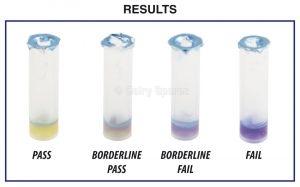
DELVOTEST® ANITIBIOTIC TEST TUBE (25PK) – BV24
Additional Information

Already a customer? Click here to login and see prices.
Delvotest is a simple and reliable microbiological test which can detect the presence of a broad spectrum of antibiotics in milk.
The Delvotest kit uses ampoules containing a culture medium and Bacillus Stearothermophilus spores. In the presence of milk and its natural nutrients, the bacteria will germ and multiply during the incubation pe- riod (at an optimum temperature of 64°C). However, if antibiotic residues are present in the milk this does not happen.
Every day, antibiotics are used to treat diseased animals and as a preventive treatment (dry-off). This means many farms risk producing milk which is contaminated with antibiotic residues, leading to financial penalties and even the cost of the entire tanker of contaminated milk. To reduce the risk and prevent being penalized, take advice on antibiotic use from your vet, understand withdrawal periods and respecting proto- cols. The use of Delvotest offers you an added security.
Follow the Delvotest 10 Point Plan to avoid contamination on the farm and ensure cost efficiencies:
1. Prevent diseases with a detailed and complete contingency plan
2. Understand the length of treatments and use the correct antibiotic dosage
3. Be very aware of withdrawal times
4. Clearly identify which animals have been treated
5. Discard the milk from all four quarters, even if only one quarter was treated
6. Isolate any dry animals
7. Confirm the estimated withdrawal period whatever the treatment
8. Keep accurate treatment records for each animal
9. Check for any antibiotic residues in milk
10. Evaluate risk to prevent future contamination
Individual cow's milk should be tested in the following cases
BV24
· Animals have been treated in an unusual way
· Cows have calved prematurely. As Dry Cow tubes can last 4 weeks to 10 weeks.
· Animals which have been recently purchased or are being milked for the first time
· Heifers are being treated before calving Tank milk should be tested when
· Animals have not been treated by the usual person
· There is any risk of contaminated milk being in the tank BV25
TI0935
B14
How to use Delvotest
A sample to be tested with Delvotest can either be taken from an individual cow's milk or a tank. The subsequent steps to be taken are explained below.
Taking a sample of an individual cow's milk
When analysing cow's milk, the test must contain samples from all four quarters as milk from non-treated quarters may also be infected. You should also be careful not to use the foremilk as this may give an inaccurate antibiotic reading.
Take a sample of tank milk.
Stir the milk in the tank before taking a sample to ensure the sample taken is representative of the whole tank.
Step 1: Preparation
Cut off the required number of ampoules with a pair of scissors. Be careful not to damage the foil of the remaining ampoules.
Step 2: Open the seal
Open ampoule(s) by punching a hole in the aluminium foil with the syringe. Mark the ampoules for sample identification.
Step 3: Take a milk sample
Attach a new disposable pipette to the syringe. Depress the plunger completely, dip the tip in the milk sample and allow the plunger to return slowly under pressure of the spring.
Step 4: Inoculation
Empty the syringe into the correspondingly marked ampoule by slowly depressing the plunger of the syringe. Use a fresh disposable pipette for each milk sample.
Step 5: Incubation
Check the temperature of the incubator (64oC ±0.5oC). Put the ampoule(s) into the incubator. Record the time and set a timer for 3 hours.
Step 6: Results
After 3 hours, remove the samples from the incubator. Read the colour of the lower 2/3 part of the solid agar in the ampoule(s) after the required incubation time.
Interpreting the results
· Fail: if the colour does not change (remains purple) the bacteria have not developed due to the presence of antibiotic residues.
· Pass: if the colour changes (yellow) the bacteria have developed, indicating no antibiotic residues in the sample. Colour interpretation
To make the colour interpretation easier, you can use the colour chart below.

